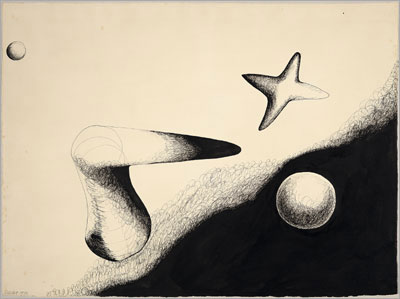

Alexander Calder, Untitled
Alexander Calder (1898-1976) occupies a position of extraordinary prominence in the history of American modernism.
Yet rarely is he perceived accurately as an artist whose formative years were passed not in America but in the ferment of the European avant-garde, especially those artists residing in Paris in the 1920s and 1930s who would exalt their own interests in the crucial "Surrealist Exhibition of Objects" of 1936. Foremost among them were Jean Arp, who coined the term "stabile" to describe Calder's constructions; Joan Miró, from whom Calder absorbed the principal tenets of Surrealism; Piet Mondrian, who introduced him to pure abstraction; and Marcel Duchamp, who provided the concept of the "mobile," or what the French philosopher Jean-Paul Sartre aptly admired as "little private celebrations of the pure play of movement."
The writer André Breton founded the Surrealist Movement in 1924 and presided over its tumultuous progress until its final demise in 1947. The Surreal Calder adopts the premise that the American sculptor was an enthusiastic and influential member of the Surrealist group between those years and that his aesthetic was profoundly indebted to that movement.
An introductory group of paintings and sculptures by Miró, Max Ernst, René Magritte, Pablo Picasso, Paul Klee, Salvador Dalí, and Yves Tanguy illustrate the varied aspects of Surrealist style and ideas that Calder would adopt.
The remaining sections of the exhibition delineate the specific ways in which Calder's interests converged with those of Dada and Surrealism in his use of playful wit and parody; in his own versions of the so-called "Surrealist Object" and related fantastic creatures; and in his depictions of both organic nature and heavenly constellations.
